OBKA Tutors Blog #7 – Catching swarms
To catch a swarm……
This article is not about swarm prevention or swarm control: that`s a whole different subject. This blog will be about what happens after they have swarmed.
Collecting swarms are good way of building up your stock, but you must register with BBKA to get your public liability insurance . I also would recommend you have experience handling bees before attempting to collect a bee swarm. A large swarm can contain 30,000+ bees with a weight off over 10lbs.
When you receive the call, try to make sure from the caller that they are honey bees and not bumble or solitary bees. This is a common mistake among the general public. Ask about the position and height off the ground of the swarm and reassure the caller. Always explain to the caller what you plan to do, and that it may involve cutting tree branches, for example. You will need their permission to enter their property, and to cut back plants or trees.
Bear in mind bees don’t read the bee manuals. The chances of your swarm being located in the middle of a conveniently low-ish hanging branch, (as illustrations like to show,) is slim, and no two swarms are the same. Usually they will first settle fairly close to the hive-nest and wait for the queen to arrive. They can settle on almost anything and any height during this period while scouts are looking for some where to live ...this can take minutes or days. When enough bees have decide that they like a spot they move towards it in a series of short hops where they wait for the queen to rest until they arrive at their new home.
(If at this point they have entered a tree cavity, for example, you can sometimes drive them out by putting heavy smoke into the entrance.)
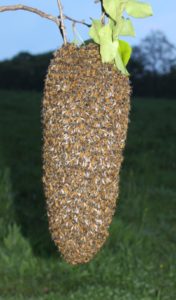
They are not always this easy....
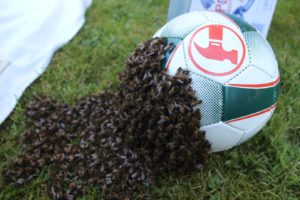
Own goal?
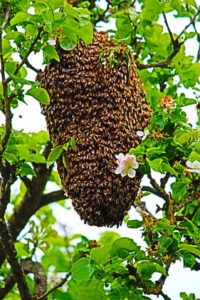
A large swarm
If you catch them resting, place the sheet under the swarm. If they are low down and on bush or tree place the swarm box underneath. Give the branch a sharp shake and the most of the bees will drop into the box. Place the box on the sheet and put the lid on. If you have got the queen in the box the rest will follow. On my swarm box there are 2 entrances when the vast majority have gone in I close the main entrance. (The second entrance has a rhombus bee escape.) it also has several holes covered with varroa flooring mesh for ventilation.
It will take about 2 hours for the bees inside to work out how get out. This method is good for getting a quick capture.
Swarms which are located on other objects, such as garden tables can be brushed into the box or if they are on the ground, place the box next to them and they should walk in.
Always cover the swarm box with a sheet to keep it cool and spray water in the air vents if it is very hot. I have caught swarms at dusk or later without a bee taking to the air - they are always very quick. One in particular I remember was on a weeping willow branch which I cut and lowered into the box, branch and all: not one bee flew up. The capture took one minute, and I got home in time for tea.
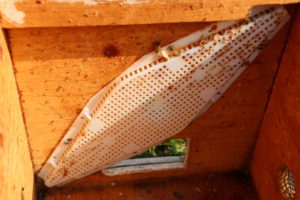
Rhombus bee escape
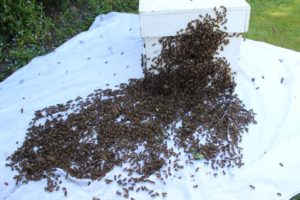
Swarm on a sheet
I love to walk the bees into the hive by putting a plank of wood up to the hive entrance. Cover the board with the sheet. If you have moved the bees gently they should be hanging inside the lid of the box.
Lift gently and shake them onto the ramp, placing a few bees by the entrance. You can then watch them walk up into the entrance. If you didn’t manage to get the queen, keep a careful eye out for her now. Remember she will be a lot smaller then when she is laying eggs. If you spot her now, it’s quite a good idea to put her in a queen catcher and place it between two frames. (Be sure to free her 2 days later when they have settled in). This is just in case they decide they don’t like their new home and take off again! An alternative to this is to put a queen excluder between the floor and brood box to keep the queen in, and after 2 days put back between the brood box and supers (making sure she is not on the supers.)
After a week I give them a feed of syrup and check for any signs of pest and disease. DON’T feed until they have used up the food in their stomachs, this minimises the risk of them bringing disease from their old hive.

Walking in the bees
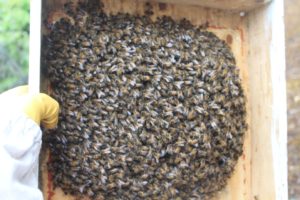
Inside the lid
This is a list of the tools I carry in my car for catching a swarm.
- Catching box – I made it large enough to take 6 standard frames. As I previously mentioned it has 2 entrances and 4 air holes. It’s large enough to catch awkward swarms very quickly with no bees flying from the box.
- Straw skep. This is a tightly woven woven upside-down basket- the traditional vessel for catching a swarm. Open at one end, so needs to be covered with a sheet.
- Old bed sheet. - placed on the ground under the swarm it helps stops bees getting lost and it’s easier to spot the queen
- Queen catcher- if you spot the queen and can catch her and place her in the swarm box, the others will follow.
- Secateurs and small saw- you may need to prune branches close to the swarm for access, or even remove the branch they are on.
- Bee brush or large (gooose/swan) feather. To gently remove bees.
- Thin rope - for shaking branches at any height.
- Water sprayer – to stop the bees flying and keeping the bees in the swarm box cool.
- Swarm catcher - made from a old bed sheet and gazebo poles which allows me to reach about 20` (much higher and it gets unstable.) I can knock bees into the swarm catcher and then tip them into the swarm box or onto a sheet and let them walk in. This method does put bees in the air!
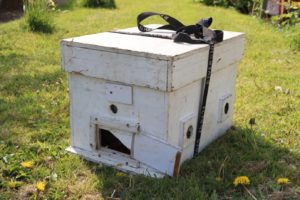
Swarm box

Swarm collecting equipment
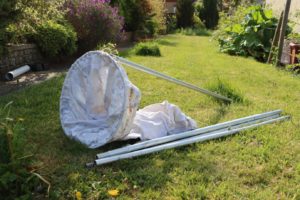
Peter Hawkins' patented swarm catcher
And finally…
Remember to always work safely and think of the property and residents. You may well also have an audience who will watch in amazement! Keep your feet on terra firma - ladders and step ladders are unsafe.
One word of warning. While swarming bees are generally docile, because they have gorged prior to leaving the hive, they still can and may sting. Bee gentle!
Peter Hawkins